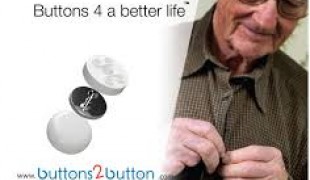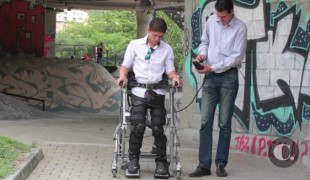- 3731
- 246
- 4
- 2
- 0
- Help Ukraine
About the solution
“I love fine food and fine dining. After the accident, I had to rely on someone to feed me because none of the assisted living products available enabled me to eat independently. Mealtime was not a dining experience; it was simply a feeding task. I desperately wanted to be able to dine again, independently, and with dignity… Even in public. It is simple things like this that seem to help each of us feel better about ourselves”, Bob explained.
Here are the Dining with dignity features:
• “Provides someone with limited hand dexterity the means to comfortably grip and manipulate conventional silverware.
• An adjustable 2-ring assembly for the thumb and index finger holds utensils on the hand.
• Easily adjusts to suit the size of any hand with the adjustable rings of the silverware.
• Unobtrusive, simple design.
• Self-consciousness is reduced.
• Restores self-sufficiency to those who currently rely on others for help in eating.
• Constructed using high quality, 10/18 stainless steel silverware.
• Works well regardless of the individual’s hand or finger strength, mobility or dexterity.
• Replaces the universal cuff and foam handles currently widely in use.
• Allows those that once needed assistance to be self-reliant and independent.
• Dishwasher safe!”
Adapted from: http://www.diningwithdignity.com/about/
What about you, do you have any solutions? Please share them with the Patient Innovation community!
This solution shall not include mention to the use of drugs, chemicals or biologicals (including food); invasive devices; offensive, commercial or inherently dangerous content. This solution was not medically validated. Proceed with caution! If you have any doubts, please consult with a health professional.
DISCLAIMER: This story was written by someone who is not the author of the solution, therefore please be advised that, although it was written with the utmost respect for the innovation and the innovator, there can be some incorrect statements. If you find any errors please contact the patient Innovation team via info@patient-innovation.com
-
-
441
-
7
-
7325

Woman creates magnetic buttons to help stepfather who has Parkinson's disease get dressed
(SELF)-CARE: DRESSING: Dressing independently.
Grip
CAREGIVING
Parkinson's Disease
Multiple Sclerosis
Bone Disorders (Decalcification, Bone Deformity, Bone Fracture, Bone Infection)
diabetes type 2
Assistive Daily Life Device (to help ADL)
Body-Worn solutions (Clothing, accessories, shoes, sensors...)
Muscle weakness
Tremors
Difficulty coordinating movements
Stiffness or rigidity (difficulty moving)
Limited range of motion
Muscle pain or stiffness
Loss of balance
Reduced grip force (grip)
Trouble with fine motor skills (e.g., writing, buttoning clothes)
Loss of muscle coordination
Muscle cramps or spasms
Joint deformity
Muscle twitching
Numbness or tingling in the extremities
Joint pain or swelling
Promoting self-management
Managing Neurological Disorders
Promoting inclusivity and social integration
Caregiving Support
Endocrinology
Neurology
Orthopedics
Rheumatology
United States
-
-
-
235
-
0
-
2772

Sam Farber husband of arthritis patient creates line of user-friendly kitchen and household products - OXO.
-
-
-
463
-
0
-
6657

Engineer develops low cost exoskeleton inspired by a friend
WALKING: Walking
MOVING IN A WHEELCHAIR: Moving using a wheelchair.
Spinal Cord and Nerve Root Disorders
Accident
Cervical spinal cord injury/Tetraplegia
Walking Aid (wheelchair/walker/crutches)
Assistive Daily Life Device (to help ADL)
Muscle cramps or spasms
Stiffness or rigidity (difficulty moving)
Paralysis of the legs and lower body
Muscle weakness
Restoring mobility
Promoting self-management
Managing Neurological Disorders
Promoting inclusivity and social integration
Preventing (Vaccination, Protection, Falls, Research/Mapping)
Neurology
Orthopedics
Colombia
-
 en
en